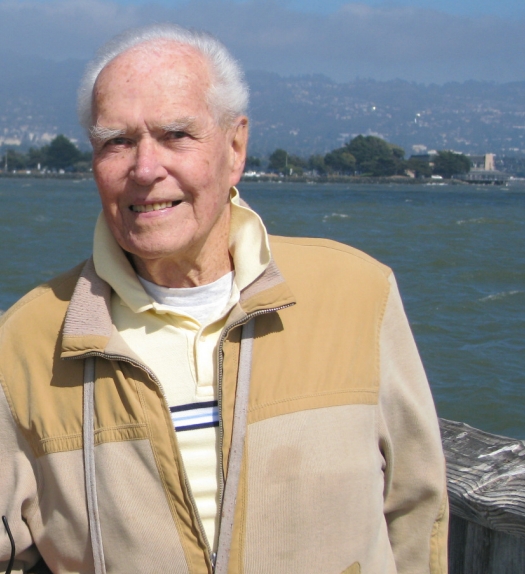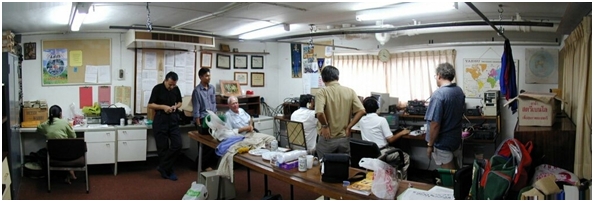
A charitable entity (No. 555) pursuant to a Ministry of Finance announcement
Prof John Hugh Jones, March 1, 1919 - September 21, 2013

Professor John Hugh Jones, M.S.,M.ASCE
Professor John Hugh Jones,
WA3SLK, HS1AIT, Silent Key
John Hugh Jones was born on St. David's Day 1919 in Utica, New York, to Lydia Williams Jones and George Cyffin-Jones, immigrants from Wales, U.K. He passed away at his son's residence in Santa Clara, CA, U.S.A., on September 21, 2013.
John Hugh, an only child, was three years old when his family moved to Los Angeles, CA. There they resided and he attended school until he was accepted to the University of California, Berkeley, and graduated with a degree in Civil Engineering May, 1941.
He married Barbara Mae Bentley of Salinas, CA, on June 20, 1942, in Berkeley, CA. He worked for Kaiser Company in Richmond, CA (shipyard design), Fontana, CA (steel mill construction) and Sunnyside, UT (coal mine operations) until he joined the U.S. Navy in 1944. During World War II he was stationed at the Hotel Del Monte in Monterey, CA (now the Naval Postgraduate School), where he taught algebra to enlisted servicemen in the Electronics Training Program, Radio Materiel School.
After the war, he returned to UC Berkeley and obtained his M.S. in Civil Engineering. He specialized in transportation and highway design. For twelve years he was a member of the faculty and of the research staff of the Institute of Transportation and Traffic Engineering at the University of California, Berkeley, and co-authored many journaled papers with Robert Horonjeff, such as The Planning and Design of Airports, 1950. In 1955, he spent his sabbatical working on the design of Heathrow Airport�s runway approach patterns, London, U.K.
In 1956, he won the Arthur M. Wellington Award in Transport Engineering of the American Society of Civil Engineers. In 1957-58 he was Visiting Professor of Highway Engineering and Traffic Studies at King�s College, University of Durham, Newcastle-Upon-Tyne, before returning to his professorship at UC Berkeley.
In 1959, he was Research Engineer and Lecturer in Highway Engineering at Northwestern University, Illinois, U.S.A. A year later he was hired by Colorado State University, Fort Collins, as Professor of Engineering at the SEATO (South East Asian Treaty Organization) Graduate School of Engineering in Bangkok, Thailand, which had been founded in 1959. At that time, Professor Jones's book, The Geometric Design of Modern Highways was published; later it was translated into several languages.
Professor Jones's twenty-month contract with SEATO Graduate School of Engineering was renewed multiple times, resulting in twenty-five years of residence in Thailand (1960-1985). In 1967, the school became the Asian Institute of Technology (AIT), an autonomous, international graduate school. For three years Professor Jones taught at Chulalongkorn University, Bangkok, Thailand, but then again renewed his contract with AIT. During his career in Thailand, in addition to being Dean of Transportation Engineering and teaching full-time, John Hugh Jones travelled throughout Asia, giving short courses, interviewing potential students, attending conferences and carrying out research. Many publications were a result of his work.
John Hugh Jones became Vice President for Academic Affairs for AIT in 1981. He and his wife established the Barbara and John Hugh Jones Prize--an award for the most outstanding transportation engineering student at AIT. This award continues to be sought after by engineering students today. For several years Professor Jones was on the Board of Trustees for AIT and was instrumental in its growth and development. He was proud to be a part of the 100th graduation ceremony in 2004 and the 50th year anniversary in 2009.
He was also a ham radio operator WA3SLK (and formerly HS1AIT) and served as a VP of the Radio Amateur Society of Thailand (RAST). In 1983 "Jonesy" helped establish a RAST club amateur radio station on the AIT campus ( a non-private location) when all other on-air HF activities had been banned, thus helping to keep amateur radio alive in Thailand. The close association established between RAST and AIT during that period still continues today.
After retiring from AIT, John Hugh Jones taught at the Institute of Technology Bandung (ITB), Bandung, Indonesia, for five years. He retired from a full, extensive, and successful career in 1989, and returned to Berkeley, California. There he continued to enjoy the companionship of his wife, children, grandchildren, and great grandchildren.
There were many activities John Hugh Jones enjoyed besides his work. John Hugh was curious about everything and loved the adventure of living, working and traveling abroad. He never doubted taking his three children on those adventures, regardless of their ages (starting when the youngest was 2). He was proud of his Welsh heritage and spoke fluent Welsh, attending St. David�s Day celebrations wherever he was in the world. He was an avid reader.
He was a sailing enthusiast and built a 14� Enterprise class sailboat; he travelled by ship extensively and loved the ocean. After his retirement he made regular trips to his fatherland, Wales, and month-long trips to Bangkok for AIT graduations until he turned 90 years old.
He is preceded in death by his parents, and his wife of 56 years. He is survived by his son, David Bentley Jones, his two daughters, Gwyneth Jones Tracy and Megan Jones Morais, his six grandchildren, and six great grandchildren. A celebration of John Hugh Jones�s life will be held at noon, October 5, 2013, at Acacia Memorial Cemetery, Modesto, California, where he will be interred next to his wife. In lieu of flowers, at your next gathering with family or friends, please raise a glass in a toast to his memory. Lechyd da! (Good health!)

John Hugh Jones (seated) joins discussions about the 1999 CQ World Wide Contest at the HS0AC club station
Reflections on Professor John Hugh Jones' legacy after he invited the RAST to establish a club station at AIT over 20 years ago
by Tony Waltham, HS0ZDX and RAST International Liaison officer
When amateur radio operators in Thailand were ordered off the air by the government in 1982, it was Professor John Hugh Jones (WA3SLK and HS1AIT) who came to the rescue by offering facilities on the campus of the Asian Institute of Technology (AIT) so that Thailand's national amateur radio society could establish a club station there.This enabled the Radio Amateur Society of Thailand under Royal Patronage of His Majesty the King (RAST), of which Professor John Hugh Jones was also a vice president at the time, to obtain permission on a regular basis from the authorities to operate during international amateur radio contests.
This club station was set up during a time when operations from all private amateur radio stations in Thailand had been suspended by the authorities while the Post and Telegraph Department was drawing up a legal framework to govern the hobby -- a period that would last for five years.
In early 1983 a competitive station had been set up in the Geotech 4 building of AIT using the callsign HS0A. The station sported a HyGain TH7 Yagi Beam for 10m, 15m, and 20m and a homemade 2-element Yagi beam for 40m.
The station was used to enter most major contests and the operators were mainly expatriate amateurs living and working in Thailand. At this stage amateur radio was still relatively new in Thailand and the art of contesting had not yet attracted the attention of most Thai amateurs.
In the first contest operation from this station in 1983, HS0A achieved first place in Asia for the CQ World-Wide Phone Contest and it went on to win many other awards. Later, after the amateur radio regulations had been promulgated and had become law in 1988, the club station callsign would change to HS0AC.
As a result of this initiative by Professor John Hugh Jones, amateur radio operations were maintained and Thailand's international reputation and its standing in the global amateur radio community were preserved while the Thai authorities were happy to authorize permission for contest activities from the club station established on the Asian Institute of Technology's campus.
RAST and many of its members, both Thais and foreign nationals living in Thailand, have been most grateful to Professor John Hugh Jones and to AIT for enabling this.
John Hugh Jones' legacy lives on today and the RAST club station at AIT has continued to function for over 20 years now, albeit with a disruption in late 2011 when the campus was swamped by flood water. However, thanks to generous donations following the flood disaster, repairs to the station are now complete and activities are now able to resume with brand new equipment using the callsign HS0AC.